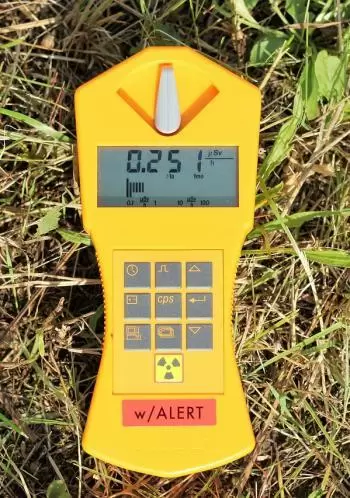
Ionizing radiation is a ubiquitous phenomenon in our daily lives, and understanding how we measure and evaluate its impact on health is essential for the safety and well-being of society.
In this article, we will explain what a sievert (Sv) is, the unit of the international system of units (SI) used to quantify the amount of ionizing radiation and its effects on human health.
The sievert and its meaning
The sievert, represented by the symbol Sv, is the fundamental measure of radiation dose and focuses on assessing stochastic health risk. But what does this really mean? In simple terms, the sievert measures the health effect of exposure to low levels of ionizing radiation, being crucial in dosimetry and radiation protection.
Dosimetry is the science of measuring radiation doses, while radiation protection focuses on minimizing radiation exposure to prevent adverse health effects. In other words, the sievert is our tool for understanding and managing the risks associated with radiation.
Use of millisievert (mSv)
The millisievert (mSv) is a unit of radiation dose measurement commonly used instead of the sievert (Sv) when dealing with lower exposure levels. One sievert is equivalent to one thousand millisieverts (1 Sv = 1000 mSv).
Since the sievert is a relatively large unit, the millisievert is used to express more typical radiation doses in medical, industrial, or environmental contexts.
For example, the average annual doses of natural radiation received by the general population are usually measured in millisieverts. Likewise, in evaluating radiation in medical tests, such as x-rays or CT scans, doses are commonly expressed in millisieverts.
Measurement tools
 Ionizing radiation, measured in sieverts, is evaluated with dosimeters. Personal dosimeters, such as thermoluminescent and optically stimulated ones, record individual exposure. Area dosimeters, such as ionization and film chambers, measure radiation in specific environments. Finally, pocket dosimeters, such as solid state and fiber optics, are portable for assessing instantaneous exposure.
Ionizing radiation, measured in sieverts, is evaluated with dosimeters. Personal dosimeters, such as thermoluminescent and optically stimulated ones, record individual exposure. Area dosimeters, such as ionization and film chambers, measure radiation in specific environments. Finally, pocket dosimeters, such as solid state and fiber optics, are portable for assessing instantaneous exposure.
A look at the man-sievert
The Man-sievert, on the other hand, is a collective measure. It represents the sum of all the significant individual quantities of a group of people during a specific period. This unit is essential for assessing the cumulative impact of radiation on a population and provides valuable information for public health policy decisions.
Equivalent dose and its biological importance
The equivalent dose, expressed in sieverts, is a measurement that indicates the amount of radiation that a specific tissue receives. Although less direct than the absorbed radiation dose, the equivalent dose is more biologically relevant.
It is calculated by multiplying the absorbed dose by a radiation weighting factor, which varies depending on the type of radiation.
This approach takes into account the different biological effects of different types of radiation, providing a more accurate measure of the potential health impact. It is a clear example of how science is working hard to improve the assessment of risks associated with radiation.
Dosage for an individual
Determining the effective radiation dose for an individual involves the use of the tissue weight factor. This factor is applied by multiplying the equivalent dose in each organ by the tissue weighting factor, which depends on the part of the body exposed to radiation. This approach offers a more accurate assessment of health risks based on the location of exposure.
The unit of measurement for absorbed dose is Gray (Gy), which represents the energy transmitted by radiation to living tissues.
Exposure limits and human health
In many countries, strict limits have been established for radiation exposure, especially for professionals working in environments with ionizing radiation.
For example, in some locations, the radiation a professional receives cannot exceed 20 millisieverts (mSv) per year, with a maximum of 100 mSv over a five-year period. For the general population, the annual average is limited to 1 mSv, excluding medical treatments.
These limits are established to prevent adverse effects on human health. Excessive exposure can lead to acute radiation syndrome (ARS), a set of negative effects caused by high exposure to ionizing radiation over a short period. Also known as radiation sickness or radiation poisoning, ARS stresses the importance of maintaining exposure levels within safe limits.
Concrete examples: nuclear disasters and extreme doses
 Nuclear disasters have provided concrete examples of the importance of understanding and respecting exposure limits.
Nuclear disasters have provided concrete examples of the importance of understanding and respecting exposure limits.
For example, in the Fukushima nuclear accident, technicians were exposed to a staggering 400 millisieverts per hour.
On the other hand, in the most infamous Chernobyl case, the total radiation estimate was raised to 80,000 sieverts, although some people received significantly higher doses.
In another incident at Tokaimura, Hisashi Ouchi suffered an extreme exposure of between 10 and 20 sieverts, marking the highest dose recorded in a human being. These cases serve as shocking reminders of the risks inherent in radiation and the importance of strict safety measures.